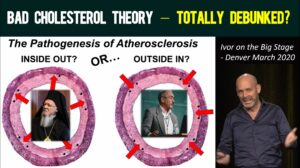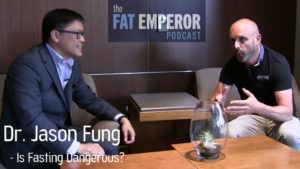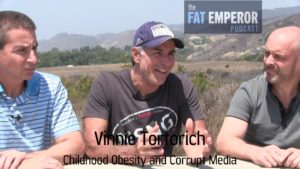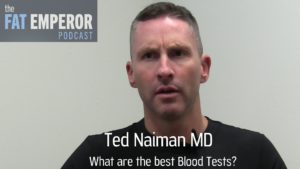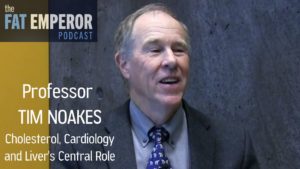Worth a post this one, from my learned and philosophical friend Murray who expounds below (Ludwig’s excellent response to Guyenet, defending his excellent book: https://medium.com/@davidludwigmd/ludwig-responds-to-whole-health-source-article-93d8e1667477#.n53p4113p ; the book is highly recommended, and available at http://www.amazon.com/Always-Hungry-Conquer-Cravings-Permanently/dp/1455533866 )
And so to Murray’s summary (warning: intellectual content ahead…!)
Okay David Winebrenner Jr, here is a (lengthy) lay interpretation of Ludwig’s response to Guyenet’s points.Two responses: one summative, one ironic.
Ironic first.
Biology is complex. It is all about rates of counteracting processes with feedbacks and nonlinear dynamics. One type of thinker engages the phenomena with intensity, duration and frequency to develop an intuition, what the eminent biologist Barbara McLintock (of Cornell, of course) described as a feeling for the organism. This type of scientist strives to develop a conceptual model of logic and mathematics to express that intuition and, over time, dialectically develops the model and the intuition. Call it empiricism. Consider how Darwin was able to sense the dynamics of genetic change over generations through intuition developed from extensive and obsessive careful observation of a range of particulars.
Another type of thinker starts with the premise of a few axioms, uses deductive conclusions to construct a theory and seeks snapshots of data to confirm the theory and to craft a rhetoric of false paradoxes to attack empirically driven models. Call it idealism, or what Lord Chancellor Bacon called the method of antecedents.
“There are and can be only two ways of searching into and discovering truth. The one flies from the senses and particulars to the most general axioms, and from these principles, the truth of which it takes for settled and immovable, proceeds to judgment and to the discovery of middle axioms. And this way is now in fashion. The other derives axioms from the senses and particulars, rising by a gradual and unbroken ascent, so that it arrives at the most general axioms last of all. This is the true way, but as yet untried.”
Or as Nietzsche observed, every syllogism is a slander against reality.
I have found it interesting that one can often sense the type of thinker from just small samples of their writing. The latter-type are forced to ignore dynamics and make logically fallacious inferences from static, context-free observations and then use insinuating rhetoric with question-begging enthymemes to denigrate rival paradigms–touchstones for this type of thinker. A touchstone example is referring to the glycogen-storage capacity of the liver strictly as an energy supply (implicitly assuming, in a bullying way without openly admitting, a bias that glucose should be the primary fuel), implying that a liver replete with glycogen is ideal, instead of expressing it as contextually dependent, being a buffer from excess dietary glucose in some situations, an emergency supply of quick energy in other situations, and a performance enhancer for certain competitive sports. Such pinched, manipulative rhetoric is oppressive and unhygienic. “Clean air! Clean air!” It is difficult to get far into blogs written in that nature–one can only hold one’s breath so long. I rarely get any new insight into the nature of things, just the nature of manipulative rhetoric.
Summative Response:
Ludwig does a fairly good job of exposing the manipulative rhetoric embedded in each of the eleven points that are asserted as refutations of the hormonal model of excess fat storage, by exposing the misleading use of incomplete, snapshot data that ignores rates, the different contexts of multi-layered dynamics and longer-term effect–things one would only perceive with a feeling for the organism.
Assertion 1: “Overeating does make you fat.” I have to interject to point out the manipulatively rhetorical use of the word “overeating.” It begs the question. How can you argue against that? Of course “overeating” makes you fat. That’s why it is called “OVEReating” with its moral connotation of gluttony. The manipulative rhetoric also uses the question-begging word “does” (which implies universal quantification–true in all cases) instead of a more neutral word like “can” (which implies existential quantification–true in some cases). The rhetoric then goes on to use existential data (it is possible in a limited experimental situation to cause fat gain by overconsumption of calories) to justify the implied universal claim of the enthymeme. (“Clean air! Clean air! Please. Clean air!”)
Ludwig calls out the bad science (without noting the manipulative rhetoric). “Not over the long term.” When a person with an undistorted metabolism overeats at a session or other short period of time, the body responds metabolically to decrease appetite and interest in food. This is why most “behaviour” studies on eating (such as calories consumed at a meal as a function of the surface area of the plate on which the meal is served) are so prone to misinterpretation. Eating 20% more calories at one meal is corrected over time by reduced appetite at the next, resulting from gene-activated responses and hormonal signals. To interpret such plate studies as meaning one should replace the china set with smaller plates in order to lose weight (as per the calories-in calories-out general axiom) is bad over-interpretation imposed on a snapshot of data that lacks a feeling for the organism, by ignoring dynamics over time. Ludwig refers to dynamical evidence (movies instead of snapshots) which shows metabolically that the over-eating follows in time the hormonal signalling and storage of fat. In other words, the movie shows that fat storage starts first and then the body catches up to the metabolism by increasing brain signals to eat more. Nietzsche (Twilight of the Idols: The Four Great Errors) refers to the first great error as mistaking effect as cause. This results from failure to perceive carefully how phenomena unfold dynamically. (Nietzsche: On the Genealogy of Morality, II:12)
Ludwig points out that other factors can distort the self-correcting metabolic balance, such as excessive insulin-stimulating foods or other factors (such as unrelenting mental stress beyond stress-load capacity). No universal claim is made by Ludwig that the metabolism always self-corrects over time. It is straw-man rhetoric to use exceptions as a refutation when the exceptions are easily explained in the theory by mechanisms that have already been established empirically. This is unlike pseudo-science where exceptions to the asserted theory are sought to be explained based on hypotheses not yet supported by empirical data and models. You cannot rescue a failing hypothesis by inventing new epi-hypotheses: that is not science.
Assertion 2: “Hunger is only one of the reasons we eat.” Again, Ludwig calls out the misuse of snapshot data and examples. One cannot prove horses fly by showing snapshots of a galloping thoroughbred with all its hooves off the turf. If I am hungry, I will choose among available foods for a variety of reasons. Food choice in a snapshot is multi-factorial (including plate size), but over time the metabolism governs how hungry we are in the long run. It is the “area under the curve” over time that predominates with an undistorted metabolism, not what makes the point-in-time peaks higher or lower. Again, the ultimate issue of concern is what distorts the metabolic dynamics, not what makes an isolated peak higher or lower.
One point I could make slightly in favour of Guyenet contra Ludwig here is the phenomenon of unconscious nutrient craving in the case of an acute nutrient deficiency. Based on the research summarized in The Dorito Effect, I have eliminated all foods with artificial flavourings (such as vanilla extract), so that I can re-educate my subliminal taste-nutrient associations. So when my body craves nutrient X, my metabolic hunger will “hedonically” favour foods with flavours that I have learned to associate with nutrient X unconsciously. Artificial flavourings are insidious, because a body conditioned to real food will crave nutrient X by seeking flavour Y, but will get added flavour Y without nutrient X and the craving remains unsatisfied, spurring further grazing despite satiated metabolic hunger. (Goats have been made to overeat this way, by (1) causing an acute nutrient X deficiency, then (2) giving them feed with added flavour Y and added nutrient X, and then (3) later causing the same nutrient deficiency and giving them access to feed with flavour Y without nutrient X. The false flavour signal causes the goats to choose and overeat the Y-flavoured feed, expecting to obtain the nutrient X.) All the worse when the falsely flavoured foods distort metabolic hunger, such as with artificially flavoured junk food that is laden with insulin-overstimulating processed starch or sugar. The CICO behaviorist crowd would blame “yummy” food, “bliss point,” colourful packaging, bowl size, wall colour, mirror placement and such, but the metabolic and nutrient-association dynamics have stronger explanatory power and generate more effective dietary strategies, such as “eat real foods.” The CICO wags (trolls sponsored by Coke?) quibble over the semantics of “real” food to rhetorically dismiss the advice as nonsense, but allow me to operationalize the definition of “real food” quite simply: “real” foods means there are no flavours added without associated nutrients (use ground vanilla bean, not vanilla extract) and the carbs are cellular and not acellular (made highly insulin-stimulating from processing).
Assertion 3: “Blood levels of fat and glucose tend to be normal or elevated in people with obesity and high insulin, not lower.” Ludwig calls out the misleading omission of dynamic context in the use of the data. “Static analysis after obesity has developed, rather than during its dynamic stages, [is] misleading.” Ludwig provides several metabolic examples that show that a snapshot of numbers can be interpreted different ways depending on context. To ignore context and impose a favoured interpretation (to support a general axiom) is misleading. I attended a speech by William F. Buckley Jr. in Toronto in the 1980s, when the Soviets were at the height of their mischief. He complained about the press’s reflexive sympathy to communism (favouring ideals over empirical reality). Imagine the Soviets push a little old lady in front of an oncoming streetcar and then the Americans push her out of the way just before she would have been struck. Headline in the Guyenet Times: Americans and Soviets push around little old ladies.
From a dynamics perspective, high blood glucose and fats are effects of developing hyperinsulinemia, where the effectiveness of insulin has been impaired and blood sugar and fat can no longer be cleared efficiently. One cannot, therefore, infer that because insulin reduces blood levels of glucose and fat in a NORMAL metabolism (without hyperinsulinemia), therefore excess insulin stimulation cannot cause obesity because both insulin and blood sugar and fats are typically elevated in the obese. The snapshot reasoning ignores the dynamic effect of excess insulin on the effectiveness of insulin in clearing blood glucose and fat.
“Clean air! Clean air!” Yes, tough going, to be sure.
Assertion 4: “Fat cells do not have an increased affinity for fat in people with obesity and high insulin.” Ignores dynamics.
Assertion 5: “Body fatness is regulated by the brain, not by fat tissues or the pancreas.” The science shows the brain processes inputs from the body. Willpower is the ability to paddle upstream: it works for a bit, but the currents (dynamics) prevail over time. Eat to change the currents instead of paddling upstream.
Assertion 6: “High insulin levels do not predict future weight gain.” See above. This again mis-uses snapshot data that changes meaning in different dynamic contexts. “Serum insulin levels [at a point in time] provide no meaningful measure of insulin action.” When one is insulin resistant, insulin levels have to rise to clear excess (tissue-damaging) glucose from the blood. The sign [elevated insulin] has different meanings in different metabolic contexts. Guyenet attempts to use the presence of the sign (high insulin) in context A (obesity from hyperinsulinemia) to prove the sign (high insulin) in context B (normal metabolism) is not predictive.
Assertion 7: “If high insulin were a major contributor to obesity, weight loss would be a positive feedback process.” Ignores changing context (insulin sensitivity) with dynamics. “[T]his reasoning conflates insulin levels and insulin action.” By eating high insulin-stimulating foods while losing weight (or failing to reverse insulin resistance), as bodyweight decreases from dietary caloric deprivation, there is greater competition between the insulin signal and the need for body energy, creating a negative feedback.
Assertion 8: “Foods that lead to higher blood levels of glucose and insulin do not result in greater subsequent hunger.” Ludwig shows that Guyenet relies on short term (up two hours after eating) and the longer term studies (up to five hours after eating) show the opposite. It is worth noting that Dr. Joseph Kraft’s seminal work on hyper-insulinemic response was derived from five-hour tests.
Assertion 9: “Diets that reduce blood glucose and insulin swings (low-glycemic) are not an effective tool for weight control.” This is the “intention to treat” problem. Dieticians (funded by Coke?) use methodology from drug trials for diet trials. The test is not which “diet” is most effective, but which “diet advice” is more effective. In a drug trial, if patients do not take the drug because it is difficult to swallow, tastes bad, has to be taken at awkward times, etc., then prescribing the drug (the intention to treat) will not be effective, even if the medication is effective. So longer-term diet studies tend to regress to the mean because compliance is bad: after a year or more the groups of participants gravitate to eating the same average diet. So the “prescription” to eat diet X is little more effective than the “prescription” to eat diet Y, even though diet X may be way more effective than diet Y when there is compliance with both.
Assertion 10: “Billions of people globally eat high-glycemic diets and remain lean.” The response is simple: “So-called “ecological studies comparing different populations comprise the lowest quality of epidemiological data.” You cannot look at one factor outside of context, which has hundreds of factors. In which of these cultures is fasting religiously followed? What rituals do they have for managing stress? What is the timing of their meals? What are their exercise patterns in relation to eating? (Chinese saying: One who climbs 100 steps after every meal lives to 99. Reason: low intensity exercise after eating helps clearance of blood sugar and reduces insulin load–area under the curve.) Any culture that has lasted a long time with a dietary challenge will have evolved compensatory foods or rituals: or they wouldn’t be a long-lasting culture. To be an insightful ethnologist, one has to develop a feeling for the culture, and to develop a talent for what the eminent anthropologist Clifford Geertz (sadly, not from Cornell) called “thick description.” Citing a single factor from cultures around the world is the epitome of “thin” description, and simply bad ethnology. One might make an existential claim (it is possible to eat high-glycemic food with compensating factors) but it is insidious rhetoric to infer a universal claim.
Assertion 11: “There is no evidence that our appetites increase, and our energy [levels drop], because our fat cells are hoovering up fat from the bloodstream.” This ignores a century of research that in the long run, biology prevails over willpower. Again, willpower is the ability to paddle upstream: it works for a bit, but the biological currents (hormonal dynamics) prevail over time. The reason Guyenet cannot accept the abundant metabolic evidence as “concrete” is that he views dynamic data in static snapshots (as above) in order to generate false paradoxes, thereby preserving his general axioms (calories-in calories-out) from which he syllogistically infers middle axioms, contra the methods of sound science since Bacon.
Ivor Cummins you might find this science and rhetoric perspective of interest.
Professor Ludwig vs. Stephan Guyenet on Insulin vs. Calories – Diet Doctor
Is our weight mostly controlled by hormones or by the brain? Is it about normalizing our fat-storing hormones (mainly insulin) or is it just about deciding not to…
